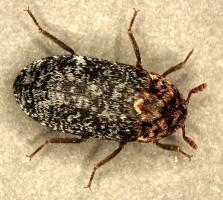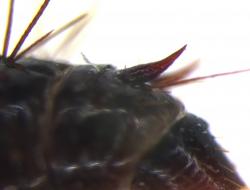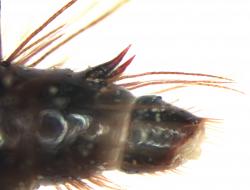About 30 Dermestidae species (84 are recorded in France) are likely to infest our museums, heritage premises, warehouses, houses,… provided that they can find the right food in them.
The Dermestes genus alone comprises more than a quarter of the species of the Dermestidae family in France, and though common in natural environments, it has the highest number of commensal species within the family.
Dermestes (literally “skin-eaters”) are mostly carnivorous and necrophagous, and their voracious, often cannibal larvae feed on bodies and remains of animals (bones, feathers, hairs, skin, flesh,…), on dessicated insects, on pupae or nymphs(see “Infested Materials” chapter).
Though brisk and quick walkers, these insects are poor fliers, but they can spot food from very long distances (several hundred meters).
The Dermestes genus is easily recognizable thanks to its sturdy, elongate oval aspect and to the absence of a median ocellus on its forehead. Six more Dermestes species are described in fact-sheets in this website: D. olivieri (= D. ater), D. carnivorus, D. frischi, D. lardarius, D. maculatus and D. peruvianus. Readers can refer to them for more information about those pests.
Dermestes undulatus is common in the South of France. It preferentially seeks skins, furs and leathers (book-bindings,…), but can also be particularly harmful to animal collections (insects, stuffed animals).
Like most other species of the genus, it is particularly attracted by dried fish. This insect is very active during the summer-time ; in the South of France, it can be observed in natural environments till the end of October, infesting remains of dead animals, bee-hives, and bird's, processionary caterpillar's or wasp's nests.
Like most other Dermestidae, it is also a very useful forensic entomology indicator for the scientific police, for its presence on a body can provide valuable chronological information for determining when death occurred.
Together with D. carnivorus, D. frischi and D. maculatus , Dermestes undulatus belongs to the sub-genus Dermestinus, whose species are characterised by a dense hairiness on the ventral face of their abdomen, which hides the cuticle from sight.


 Dermeste bigarré
Dermeste bigarré 




